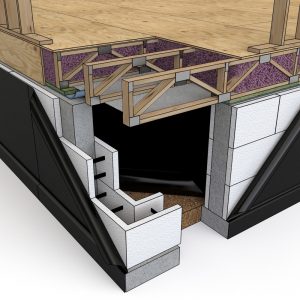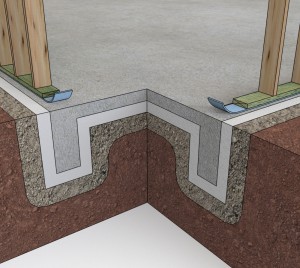Questionable Guidance from the IRC
The International Residential Code (IRC) identifies two different ways to build a new-home crawl space that resists frost heaving: place the footings below the frost line (historical frost-depth) or heat the a home to 64 degrees for eternity. The frost line in cold climates is between 42 and 96 inches so most cold-climate crawl spaces don’t have their footings below the frost line.
Why the Ground Underneath a Home is Warm
Some code officials reason that interior foundation-wall insulation or crawl-space floor insulation denies the foundation the heat it needs to avoid frost heaving.
Builders often install too little foundation and floor insulation because of a belief that the winter ground temperature isn’t nearly as cold as the outdoor air temperature, and therefore heat loss through the ground is negligible. The main reason the ground is warmer than the outdoor air is that the homeowner is heating the ground with heat from the furnace or boiler.
The ground is cold enough and conductive enough to be the largest heat-loss component for the otherwise energy-efficient homes being built in Alaska and other cold climates. Besides being wasteful, perpetual ground-heating isn’t a good assumption in Alaska and the Northern tier of States, which have many seasonal residents. Some seasonal residents supply little or no heat to their vacant homes during the winter.
Why the IRC Guidance Doesn’t Make Sense
What if oil and natural gas prices rise sharply? Won’t homeowners with uninsulated floors decide to insulate them? Floor insulation is cost-effective now. Builders should find a way to provide insulated floors to their customers with crawl-space foundations.
Our most energy-efficient builders insulate the wood-frame floor above the crawl space by filling the floor cavity with fiberglass batts or blown fiberglass insulation. With the floor’s heat loss minimized by the floor insulation, these builders use insulated concrete forms, or exterior footing-and-foundation insulation to protect the crawl-space foundation from freezing temperatures.
Our Recommendations for Cold-Climate Foundations
We at Saturn believe that with ICFs, insulated footings, and a well compacted base including six inches of compacted gravel, the frost-heaving risk is small for most cold-climate home sites. We also recommend against insulating crawl-space foundation walls or floor with fiberglass batts because of our concerns about the batts’ durability.
If these recommendations make crawl spaces too expensive, build basements instead and charge for the extra value. Or save money and build a frost-protected shallow foundation with plenty of foam insulation bordering the footing and concrete slab. When in doubt about your the supporting soil or what type of foundation is best, consult a local civil engineer.



So John, I’m still thinking about my house design for NE Washington. I couple of things came to mind as I read your blog. Moisture content and soil type have a big impact on both frost heave and on below grade heat loss. I would think that the need for sub-slab insulation would be less in the center than the at the edge (radial pathing) and considerably so where the soil has low conductivity. I am also intrigued with the use of rigid/waterproofed rockwool panels (Roxul) as an alternative to foam. Any thoughts?
Russ, you should put at least four inches of 25 psi under the slab. I’ll write another blog soon on shallow frost-protected foundations. I love Roxul rock wool products but the board is quite a bit more expensive than EPS. You’re near a lake I believe. If you build a basement, you should go all the way with your waterproofing and Roxul fits right in. Rock Wool is hydrophobic and it drains.